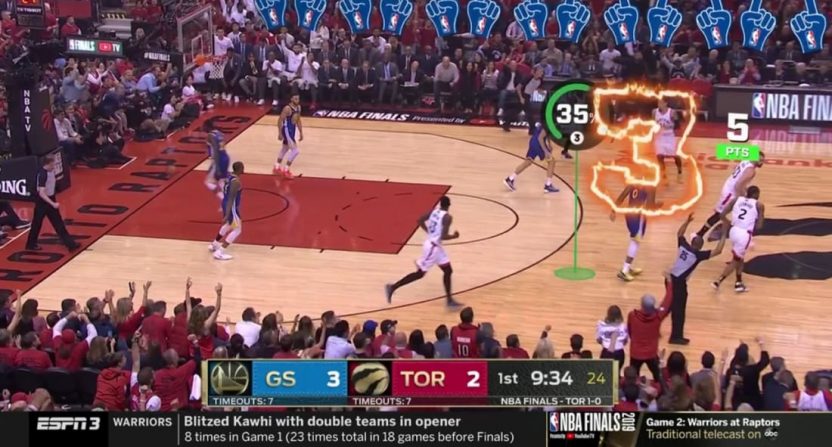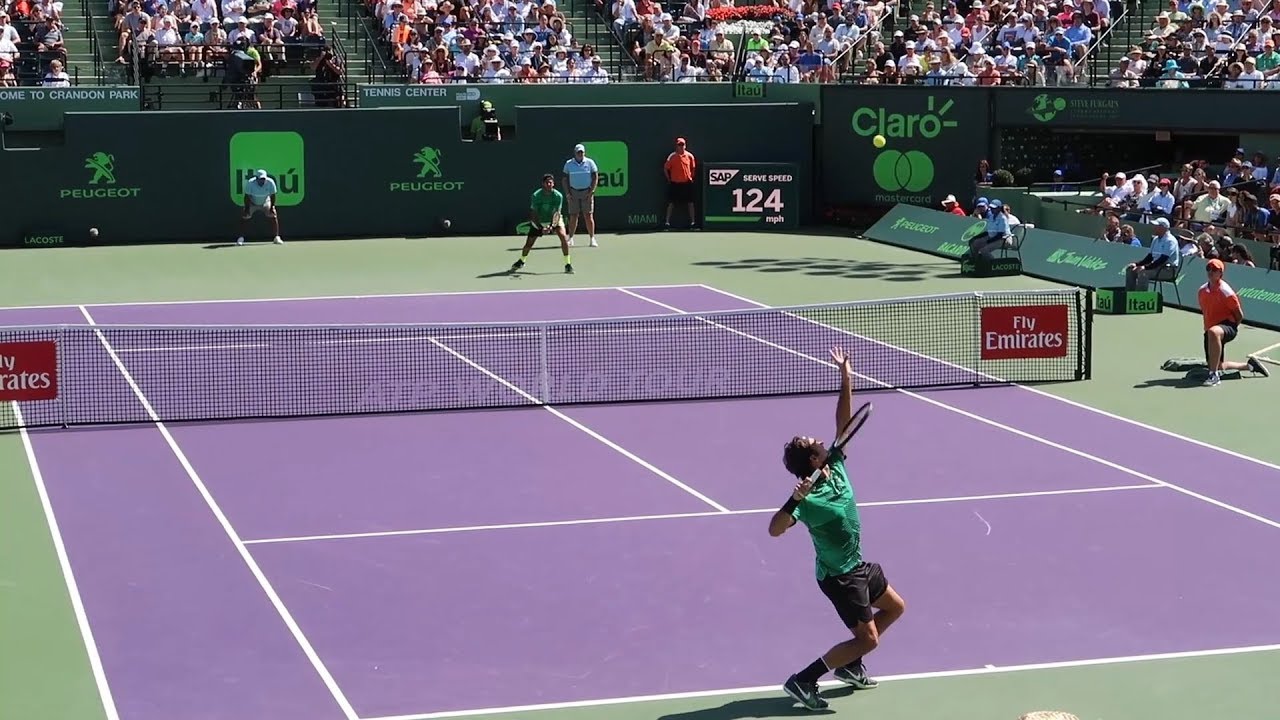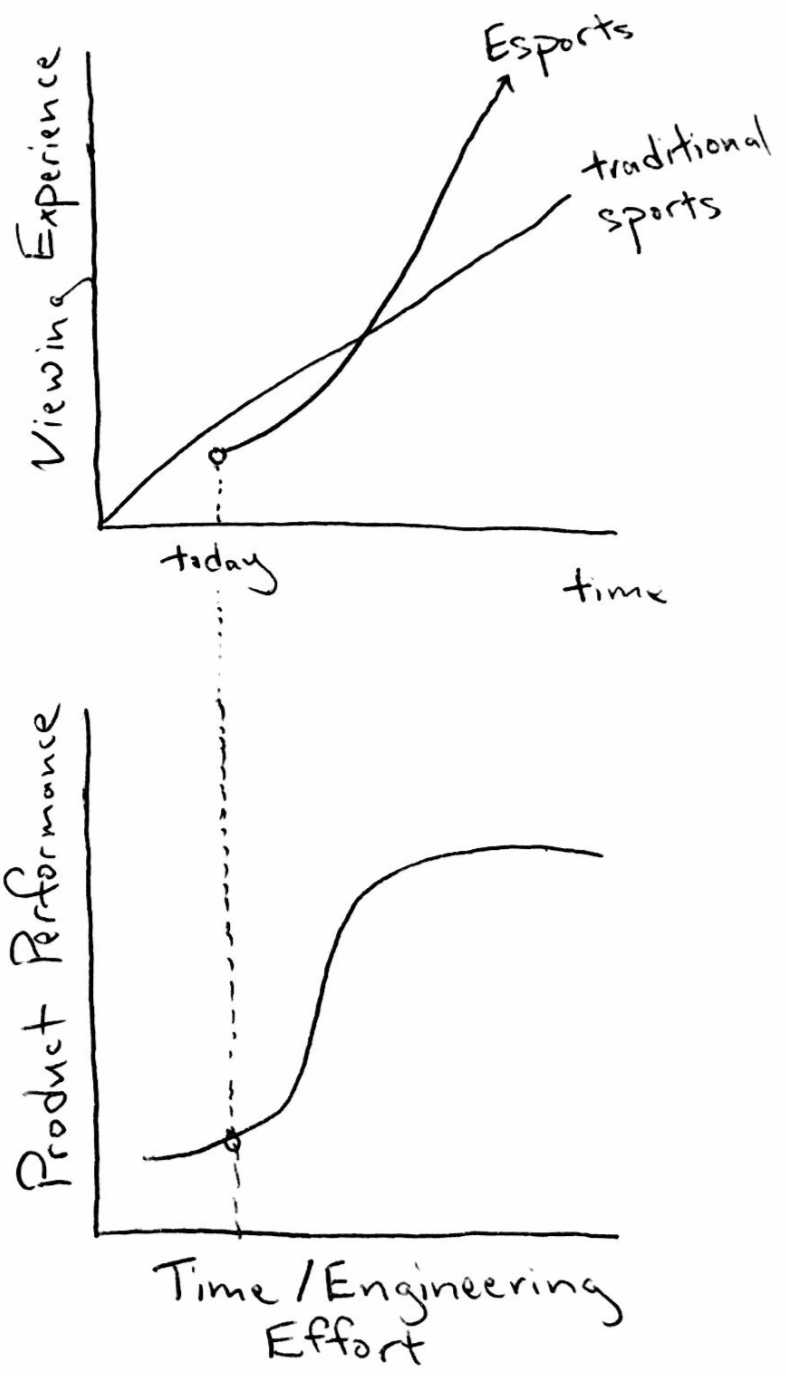Watching people play video games has always been an inferior experience to watching live sports. This will change in the coming years. Understanding the why and how this dichotomy reversal is critical to envisioning the future competitive positioning of Esports.
For the longest time, the Esport viewing expierence has mirrored that of traditional sports. The game is presented from almost a birds eye view and there is some version of a scoreboard, normally on the top or bottom of the screen. There is a team of announcers made up of play-by-play casters and a color commentaor (the hype man).
It doesn’t have to be this way.
While it has worked great for television, the traditional sports viewing experience is constrained by its physical nature and has not taken advantage of streaming. Esports does not have the physical constraints.
In order to understand why this is such an important distinction, I look to Basketball to servce as the corollary for traditional sports.
Basketball
Dr. Naismith invented Basketball in 1891 as a conditioning exercise in the winter. Before long, it became a spectator sport and was first televised during the ‘experimental era’ in 1940. The NBA was founded in 1946.
While we are used to watching Basketball on a screen nowadays, it was always meant to be experienced live. It’s clear that the television and streaming experience were build around the game of Basketball instead of the other way around.
There are a number of problems with this.
Firstly, the streaming viewing experience is almost identical to on a TV. This should be unnaceptable for viewers. Why? A computer is extremely powerful and capable of providing an interactive viewing experience, but TVs for the most part are non-interactive and static.
The reason the two are still the same is the infrastructure required to provide an upgraded streaming experience is expensive and mostly unasked for. It requires expensive cameras and tons of production infrastructure to include additional points of view, and people have gotten used to the status quo.
Additionally, the actual physical constraints of the court and players make it difficult to record and broadcast a truly immersive experience. The players run across the entire court, often unpredictably, which precludes broadcasters from putting cameras within the court itself.
What we are left with is the birds-eye view of the court that we are used to. With time the viewing experience will slowly improve, but it will still be gated by physical constraints.
To their credit, some major broadcasters are attempting to work on it.
ESPN experimented with a ‘kid-friendly’ ESPN2 stream during the NBA Finals this year. They added additional graphics meant to replicate popular video games like NBA 2K.

It looked horrible. While they had good intentions, the execution was far below what viewers can expect to find onn Twitch on a day-to-day basis.
ESPN is clearly playing catchup, but unfortunately for them streaming is one of Esports’ strengths. Streaming is the future, and traditional broadcasters are either going to need to acquire talent or slowly admit defeat.
This competitive advantage for Esports will compound with time.
3D vs 2D
Unlike Basketball, video games were created on computers for computers. The input and output are both digital, which makes it significantly easier to manipulate.
Imagine looking at a marble on your desk. If you bring the marble up to eye height, you can see its spherical 3D shape. Howeer, if you stand directly above the marble, you’ll only see the circle that makes up its circumference.
Now imagine drawing a perfect circle with the same circumference as the marble. If you stand directly above the circle this time, you’ll see that it looks close to equivalent to the marble from the same vantage point. However, if you hold the paper up to eye level you won’t be able to see circle at all.
When moving between dimensions, a 3D object can be easily translated into a 2D object, but the reverse is not true. When it comes to streaming, a digitally native product is similar to a 3D object because you can manipulate the game data in 3D space.
Cameras capture 3D images but the input is physical, so they are more akin to a 2D object in terms of information captured.
Despite its inherent advantages, Esport streams have mimicked that of traditional broadcasting because it’s a format that viewers are familiar with. It makes sense to appeal to the familiar when you are a nascent industry, but it’s time to move beyond.
League of Legends, the most popular Esport to date, has done just that. They are moving past the free, familiar stream through a paid upgraded stream they’re calling Pro View.
Pro View
Pro View is very important for the Esport ecosystem because it shows innovation in production and a willingness to charge for new services. These are both important for different reasons.
On the production side, Pro View finally takes advantage of gaming’s digital origins. Pro View comes with a few additional features.
- Player POV streams so viewers can see exactly what the pros see, from mouse clicks to button presses
- Multiview: The ability to watch up to four streams from different points of view from the game.
- Advanced Timeline: Kills, towers, and other big plays are timestamped on the game’s timeline, allowing you to jump to specific moments by clicking a marker
- Watch With Friends: You can share a personalized Pro View URL with your friends to ensure you are watching the same thing at the same time as them
A few of these features can and will be replicated by ESPN, specifically advanced timeline and watch with friends. However, it’s important to note that these advances only apply to the streaming experience, and not to the television. A large portion of ESPN’s audience watches through the TV which disincentivizes prioritizing streaming upgrades.
To their credit, ESPN’s experiments with the ESPN2 stream showed they are concerned with improving the streaming experience. However, they probably aren’t approaching it with the same intensity that gaming companies do. The bifurcation of viewers from Esports and traditional sports make it so improvements in one aren’t necessarily demanded in the other.
Even if ESPN wanted to copy everything Esports does (they won’t), they wouldn’t be able to.
While Google Glass and Focals by North allows for POV recording, we are years away from contact lenses that could record/transmit games from a player’s POV.
Furthermore, it’s difficult or even impossible to display exactly what the player is doing when they move on court. Imagine trying to show viewers exactly how Kawhi pushes off with his left foot and raises his right arm. Pretty hard right?
It’s much easier for video games, where character movements are easily defined as mouse clicks and button presses.
The Multiview has existed in a sense on Direct TV for years, as they’ve allowed viewers to split their screens to watch multiple games at once. However, the limitations of camera technology and positioning make four viewpoints from a single game superfluous.
Therefore, we are beginning to see the Esport advantage manifest.
While it’s great that Riot Games (creator of League of Legends) has shown its willingness to push the envelope, it’s critical that they are incentivized to continue. The additional revenue generated by Pro View will be that incentive.
Until now, streams of professional games were free to view. Individual games partnered with companies for sponsorships (eg. State Farm Analyst Desk for League of Legends) and ads, but lack the valuable bargaining deals the NBA/NFL command.
Since Esports are not all positive cash flow, the value they add for the game publishers has been advertising for the given game. Riot Games currently makes ~$2 billion in revenue per year, mostly from in-game cosmetic upgrades known as ‘skins’.
Pro games keep casual and hardcore players engaged, and players advertise skins by using them in games.
Pro View is a departure from this model because it’s revenue generating. By generating incremental revenue, Riot can reinvest the profits to further improve (and charge more for) their streams.
If skins were the only avenue of revenue generation, publishers may be disincentivized to invest in stream improvements.
I believe the features of Pro View are only the beginning. The digital native nature of video games allows for continual improvement at a lower marginal cost relative to traditional sports.
In a few years from now, the viewing experience will be completely different to today’s. I am a fan of imagining the future, so here are a few of the improvements I could see being implemented.
The Future
If you are a fan of tennis, you’ll know that they occasionally show matches from a lower vantage point. It’s normally very brief, but it allows us to see from almost a court-side perspective. I personally find a lot of value and enjoy watching tennis from that point of view, but it’s unfortunately very rare.

I have no idea why they don’t show more of matches from that perspective, or even have an option to watch a match completely from that point of view. With Esports, I believe this will be a ubiquitous feature.
Viewers will be able to click and drag the screen to see the game from different points of view, similar to how satellite view currently works on Google Maps. While there may still be the same announcers and casters, each person would have their own ‘personalized’ stream.
In addition to the advanced timeline upgrade mentioned before, viewers will be able to rewind streams and watch certain parts in slow motion. This will be especially beneficial for people watching from a player’s POV, as they can better understand what they were doing.
When viewers click on highlights from the timeline, there will be options to bring up graphics on the button and mouse presses of players in that moment. They will be able to study the patterns of pros, and in turn improve their own gameplay.
Improving by watching the best will make games sticky and keep players interested. Not every viewer will take advantage of these features but they will be useful for new players as well as hardcore players that have seen their improvement plateau.
I would argue that Esports as an industry is at the bottom of the S-curve of innovation. As the rate of innovation increases the advantages Esports holds over traditional sports will continue to compound.

Soon, the viewing experiences will be so incomparable that even the most die-hard sports fan will be left wanting more. In part 2 of my competitive analysis of Esports, I will discuss in further detail what the future may look like, and why the companies of today may not be the companies of tomorrow.